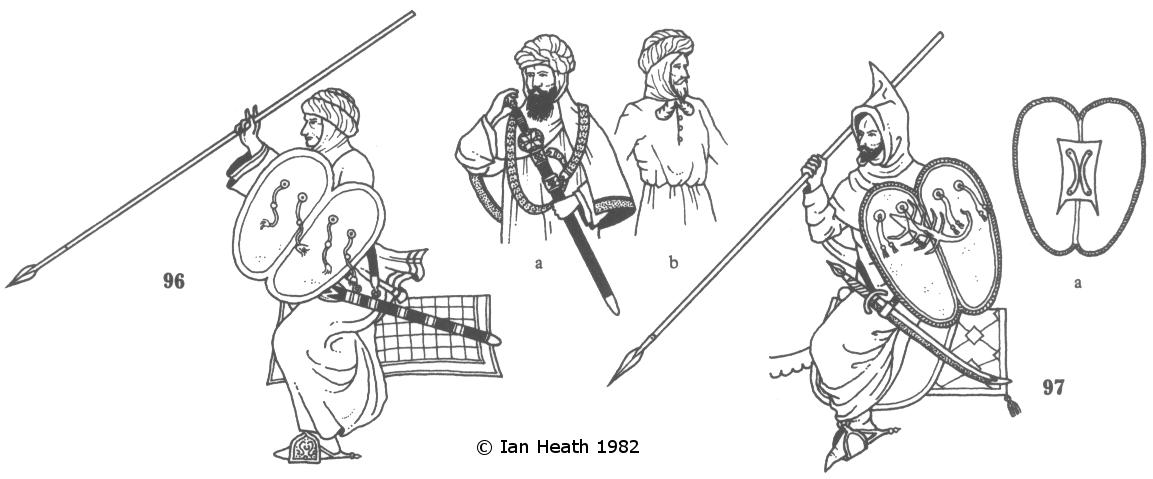|
|
GRANADINE CAVALRYMEN, 14th-15th CENTURIES
An extract from Armies of the Middle Ages, volume 1
by Ian Heath
96 & 97. GRANADINE CAVALRYMEN, 14th-15th CENTURIES
These 2 figures are typical of those to be found in literally dozens of pictorial sources of this period.
Both belong to much the same date, 96 being from the same source as figure 84 while 97 comes from an altar-piece of c. 1400.
Their costumes are basically the same, though 97 wears a hooded cape in place of the turban, and they carry the same arms comprising adarge, sword and javelin.
Interestingly every picture of such horsemen that I have ever seen has shown only one javelin being carried, but the consensus of opinion is that 2 was the norm.
Froissart, speaking of a Berber horseman of the Hafsid Caliphate in 1390, says that customarily 3 javelins were carried, 'feathered and headed with iron; and well he knew how to wield them, to throw them, and to recover them', a description that fits Granadine horsemen equally well.
The javelin was used not only as a missile but also as an overarm thrusting weapon, in which role we often see it held well forward of its centre point, sometimes within 18" of the blade.
The sword, called in Spanish sources an espada jineta, was carried in a baldric.
Both hilt and scabbard could be richly decorated, particularly in the case of kings and amirs, and the baldric itself could be of gold, silver and silk or brocade (see 96a, depicting a king).
The adarges are both of the usual shape to be seen in sources of this period, looking somewhat like conjoined kidneys, though the earlier heart-shaped types are also still to be found right up to 1492.
It is probably the adarga that Froissart is describing when he speaks of the Berbers' 'very light shields,
covered with cuir-bouilli of Cappadocia which, if the leather has not been overheated (in the boiling), no weapon can penetrate'.
An earlier source which describes the adarga as 'proof against sword and lance blows and the majority of arrows' would seem to bear him out, though Froissart contradicts himself on the subject of crossbow bolts, stating in one place that these too 'glanced off their shields' and in another that their shields could not protect the Moslems from the Genoese crossbowmen's bolts.
It should also be noted that an adarga in the painting from which 97 comes is shown being pierced through by a Spanish knight's lance.
This source also demonstrates the construction of the adarga, seen quite clearly in the back view given in 97a; note the reinforcing central panel to protect the hand-grip.
Shields in this source are invariably red, tan or brown (probably varnished leather), with red or black tassels, two carrying in addition simple motifs of a scorpion (shown here) and a terrapin, both painted in light brown (proper?).
Adarges in the 13th century 'Cantigas de Santa Maria' are shown in a wider range of colours including red, yellow, black, or white with a red rim.
That of 96 is white with gold studs and tassels.
The clothes of figure 96 comprise an ankle-length red tunic over a white undershirt, with a blue-embroidered sash round his waist and a white turban.
The baldric is black, the scabbard red with gold or gilt fittings, and the saddlecloth white with red decoration.
The painting from which 97 is taken shows turbans, hoods and keffiyahs in various shades of blue, red and brown as well as white, with tunics in rich brocades and dark colours, with red and brown again predominating.
Boots are mainly red, with prick spurs worn on the heels.
The ornate stirrups, worn short, were in widespread use in Spain even amongst Christians.
96a and b show two details of dress, the hood worn by 96a presumably being the garment described in Castilian sources as the 'Moorish mantle' or albornoz.
Next: 98. GRANADINE MOUNTED CROSSBOWMAN, 14th CENTURY in Armies of the Middle Ages, Volume 1 by Ian Heath
|

